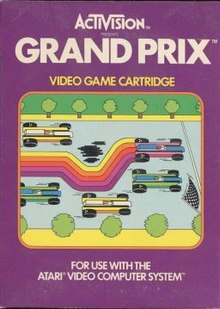
The Atari 2600 is a home video game console developed and produced by Atari, Inc. Released in September 1977 as the Atari Video Computer System, it popularized microprocessor-based hardware and games stored on swappable ROM cartridges, a format first used with the Fairchild Channel F in 1976. The VCS was bundled with two joystick controllers, a conjoined pair of paddle controllers, and a game cartridge—initially Combat and later Pac-Man. Sears sold the system as the Tele-Games Video Arcade. Atari rebranded the VCS as the Atari 2600 in November 1982 alongside the release of the Atari 5200.

Pole Position is an arcade racing simulation video game released by Namco in 1982 and licensed to Atari, Inc. for US manufacture and distribution, running on the Namco Pole Position arcade system board. It is considered one of the most important titles from the golden age of arcade video games. Pole Position was an evolution of Namco's earlier arcade racing electro-mechanical games, notably F-1 (1976), whose designer Sho Osugi worked on the development of Pole Position.

Kaboom! is an action video game published in 1981 by Activision for the Atari 2600. The gameplay was based on the Atari arcade game Avalanche (1978), with the game now involving a Mad Bomber who drops bombs instead of falling rocks. Kaboom! was programmed by Larry Kaplan with David Crane coding the graphics for the buckets and Mad Bomber. It was the last game designed by Kaplan for Activision, who left the company shortly after the release of the game. The game was later ported by Paul Wilson for the Atari 5200 system.

Pitfall! is a video game developed by David Crane for the Atari 2600 and released in 1982 by Activision. The player controls Pitfall Harry, who has a time limit of 20 minutes to seek treasure in a jungle. The game world is populated by enemies and hazards that variously cause the player to lose lives or points.

David Crane is an American video game designer and programmer. Crane grew up fascinated by technology and went to DeVry Institute of Technology. Following college, he went to Silicon Valley and got his first job at National Semiconductor. Through his friend Alan Miller he learned about potential video game design work at Atari, Inc. and began work there in 1977.
Geoff Crammond is a computer game designer and programmer who specialises in motor racing games. A former defence industry systems engineer, he claims to have had little interest in motor racing before programming his first racing game (Revs) back in 1984, but he holds a physics degree, which may explain the realism of some of his programming. As a consequence of that project he became a big fan of Formula One motor racing. At the end of the 80s, this interest, plus the ever improving capabilities of home computers, inspired him to specialise in programming Formula One racing simulations.
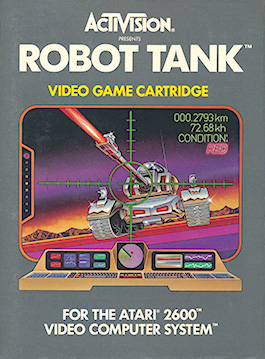
Robot Tank is a first-person shoot 'em up written by Alan Miller for the Atari 2600 and published by Activision in 1983. It is similar in design to Atari, Inc.'s Battlezone tank combat arcade video game and more so to its 2600 port. Robot Tank adds different systems which can individually be damaged—instead of the vehicle always exploding upon being shot—and weather effects.
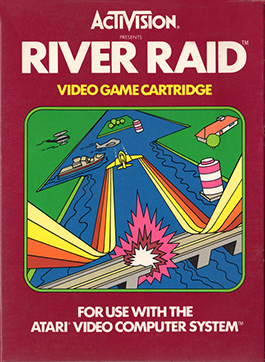
River Raid is a video game developed by Carol Shaw for the Atari Video Computer System and released in 1982 by Activision. The player controls a fighter jet over the River of No Return in a raid behind enemy lines. The goal is to navigate the flight by destroying enemy tankers, helicopters, fuel depots and bridges without running out of fuel or crashing.

Pitfall II: Lost Caverns is a video game developed by David Crane for the Atari 2600. It was released in 1984 by Activision. The player controls Pitfall Harry, who must explore in wilds of Peru to find the Raj Diamond, and rescue his niece Rhonda and their animal friend Quickclaw. The game world is populated by enemies and hazards that variously cause the player to lose points and return to a checkpoint.
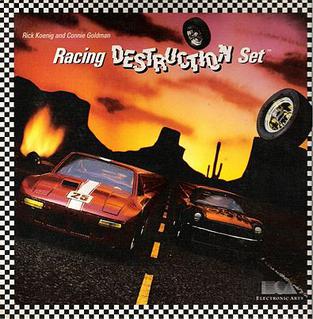
Racing Destruction Set is a racing video game published in 1985 for the Commodore 64 by Electronic Arts. It was advertised as being Commodore 128 compatible. A version for the Atari 8-bit family, programmed by Rebecca Heineman of Interplay, was released in 1986 in the United States, United Kingdom, and Germany. The game allows players to design and race on tracks with a variety of vehicles. It is part of the Construction Set series along with Pinball Construction Set, Music Construction Set, and Adventure Construction Set.

Fishing Derby is a fishing video game written by David Crane for the Atari Video Computer System and published by Activision in 1980. It's one of the first video games developed by Activision.

Megamania is a video game developed by Steve Cartwright and published by Activision in 1982. The game is a fixed shooter, where a pilot of an intergalactic space cruiser who after eating a variety of food, has a nightmare where his ship is being attacked by food and house hold objects. Using the missile launcher from his space cruiser, he finds himself being attacked by various food items and house hold objects.

Enduro is a racing video game designed by Larry Miller for the Atari 2600 and published by Activision in 1983. The object of the game is to complete an endurance race, passing a certain number of cars each day to continue the next day. The visuals change from day to night, and there is occasional inclement weather.

Cosmic Ark is an Atari 2600 game designed by Rob Fulop and published by Imagic in 1982. The objective is to gather specimens from different planets in a spaceship which contains the survivors from the city of Atlantis. There are two versions of the cartridge. One allows the player to toggle the starfield display with the Black & White / Color TV switch. In the other the starfield cannot be disabled.

Barnstorming is an Atari 2600 video game designed by Steve Cartwright and published by Activision in 1982. It was the first game designed by Cartwright. The idea for Barnstorming came to him as he watched a biplane one day while driving home from work.
Ever since Pole Position in 1982, Formula One (F1) has always played a part of the racing genre in video games. Early Formula One games were typically arcade racing games, before Formula One Grand Prix (1991) popularized Formula One racing simulations on home computers.

Skiing is a video game cartridge for the Atari 2600. It was authored by Bob Whitehead and released by Activision in 1980. It's one of the first video games developed by Activision.

Street Racer is a racing video game developed for the Atari Video Computer System, later known as the Atari 2600. It was programmed by Larry Kaplan and released by Atari, Inc. in September 1977 as one of the nine Atari VCS launch titles. The game was also published by Sears for their Tele-Games product line as Speedway II.

Sky Jinks is a vertically-scrolling, air racing-themed video game developed by Bob Whitehead for the Atari 2600 video game console, and published by Activision in 1982.
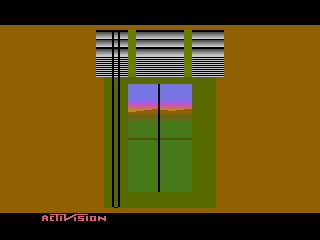
Venetian Blinds is a simulation video game developed by Activision co-founders David Crane and Bob Whitehead for the Atari 2600. The game simulates the raising and lowering of Venetian blinds on a window, and was facetiously presented as a technology demonstration of Whitehead's graphical programming technique of the same name, although it does not use the technique.
